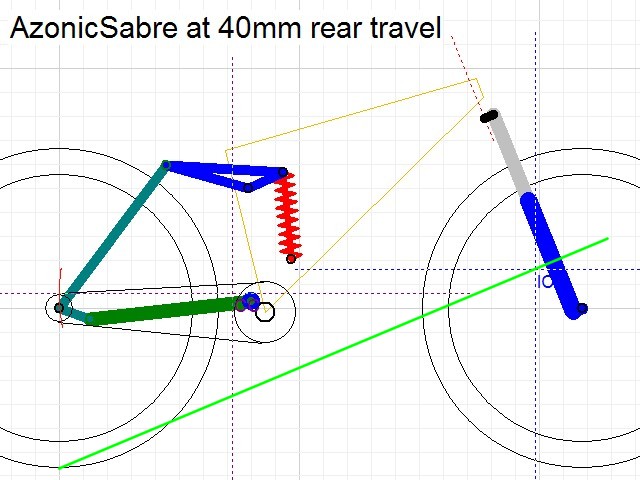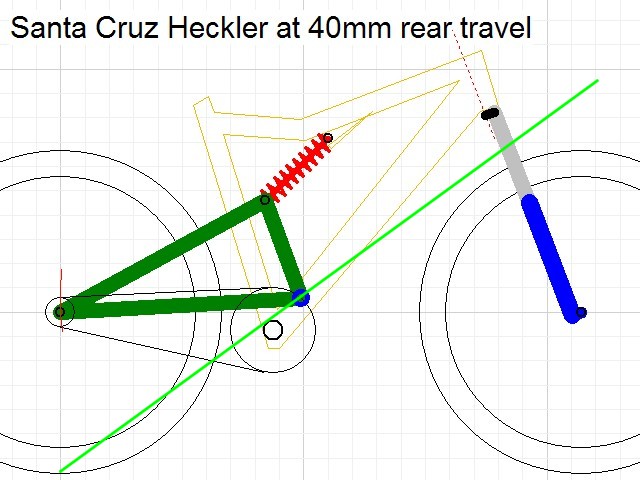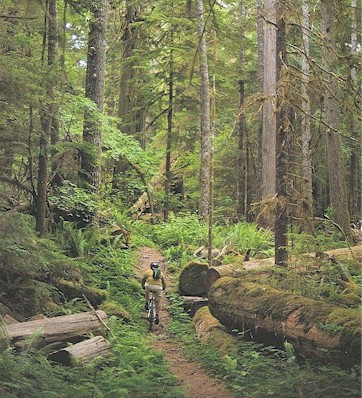Do You know Jack?
Contains:
When you apply the rear brake on a full suspension bike you're adding another outside force to the suspension system. Ideally we want to minimize the effect of the braking force to provide suspension which under braking can still absorb bumps, provide traction and not react violently or upset the stability of the bike.
To stop a bike you apply the brakes.
That creates a force at ground level and another (equal and opposite) through your centre of mass (COM) to slow you down
Between these two forces you have suspension pivots and/or a linkage that can behave in several different ways.
This is good for traction and suspension action but reduces the stability of the bike.
If you apply a force to a linkage then you also exert a torque on that linkage.
The formula for torque is force*distance (to pivot). Under braking we have two forces acting about one pivot (or the IC for a four bar linkage), the traction force and the reaction at your COM.The behaviour of the suspension depends on the location of the pivot (or IC) in relation to these two forces.
When concerned with braking behaviour we can split all current bike designs into two categories, 4 bar linkages and monopivots.
These classes are not as clear cut as they appear. A seatstay pivot linkage design with the brakes mounted on the swingarm (Kona, Giant AC etc) is classed as a monopivot and macpherson strut bikes (AMP style) are classed as 4 bar linkages.
In the case of monopivot bikes (including URT and all it's evil siblings) the brake pivot is the main pivot. You can ignore the following paragraphs.
MacPherson strut bikes, Horst link bikes and seatstay pivot 4 bar linkage bikes all behave according to the position of the Instant Centre (IC), we'll use this as the brake pivot and below you'll be told how to find it
Here's how we find it.
Take a picture of a 4 bar linkage bike, draw a line through the pivots of the lower swingarm and then the pivots of the upper link. Extend these lines either until they cross or until you run out of paper. If they cross we call this point the Instant Centre (IC). If they remain parrallel we say the IC is at infinity, a long way ahead or behind the bike. In this latter case any line parrallel to the upper and lower links is said to go through the IC.
The IC can move a great deal as the suspension compresses (this can be a good thing). For this reason we are most interested in the IC position with the bike sagging as it would normally be ridden.
The coordinate system we use takes the rear tires contact patch (with the ground) as the origin and has axes extending up vertically and horizontally.
All we need to do now is measure the angle from the horizontal axis to the brake pivot in an anticlockwise direction about the origin (contact patch).
Measure the angle starting at 0 degrees.
Here is a picture of an Azonic Sabre, a four bar linkage featuring a horst link. The IC has been found and the line from contact patch to IC drawn in for you.

A positive angle means the bike will squat, the smaller the angle, the less squat (i.e. closer to neutral) the suspension will be with the rear brakes on. There are a few bikes (GT LTS) which have a rearward IC, this results in the suspension actively extending (jacking) when the brakes are applied. Jacking is not a good thing.
The analysis here is very simple. The brake pivot is the main pivot and the same rules apply.
Measure the angle from the ground to the main pivot about the tire contact patch.

All monopivots have a compression effect (suffer from squat) under braking and the effect is generally greater than a four bar. You can easily see that from the above examples.
Unlike four bars, monopivots cannot suffer from brake jack. The suspension can only try to squat under rear braking which reduces traction and hinders the suspension action.
Monopivots which are fitted with floating brake arms become four bar linkages when predicting the braking behaviour.
Brakes also cause the bike to decellerate. This brings up a forward acting force through the combined centre of mass (COM) of the bike and rider which opposes the traction (braking) force from the ground.
This generates a forward weight shift, causing weight to move from the rear wheel to the front and with neutral suspension causing the front to compress and the rear to extend. With enough compressive effect we can cancel the rear suspensions extension, gaining stability but losing a degree of traction and suspension action.
We can use simple geometry to solve the problem of finding the overall effect of braking decelleration and the rear suspension interaction.
Simply use the line we've already drawn through the rear tires contact patch and the brake pivot. Extend this line up and past the combined centre of mass (which should be somewhere just below the riders chest).
If the centre of mass (COM) is above this line then there will be a net extension effect under braking, if the COM is below this line then there will be a net compression effect under braking.
The further the COM shifts from this line the bigger the overall effect will be, further up means more extension, further down means more compression. Seat height can change this dramatically.
There is a long held story that monopivot rear suspension systems don't handle bumps as well as a 4 bar linkage when the rear brake is applied.
This is due entirely to the squat inherent in their rear braking. Monopivots have a greater squat effect than your typical four bar. This squat results in a bike that is more stable and level under braking, but the price is a great hinderance to suspension behaviour.
The rear wheel rotates around the main pivot with the brake on, so for the rear wheel to move vertically over a bump, it must move rearward a significant amount, reversing each movement when the bump is traversed.
This forward and rearward movement results in losses to friction and extra damping. The result is extra harshness and less traction with the rear brake on.
Exactly the same phenomenom affects all suspension designs, a four bar with a large amount of squat designed in will handle bumps just as badly as a monopivot. But in general four bars are closer to neutral which gives less fore/aft movement and greater bump sensitivity with the brakes on.
 Never forget, we are in this sport for the fun we get out of it. (Photo sent courtesy of Scott Chiz). |